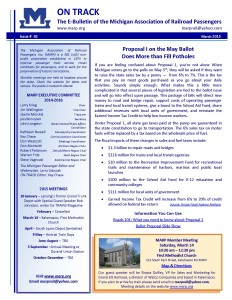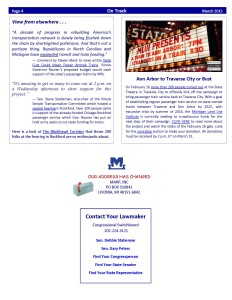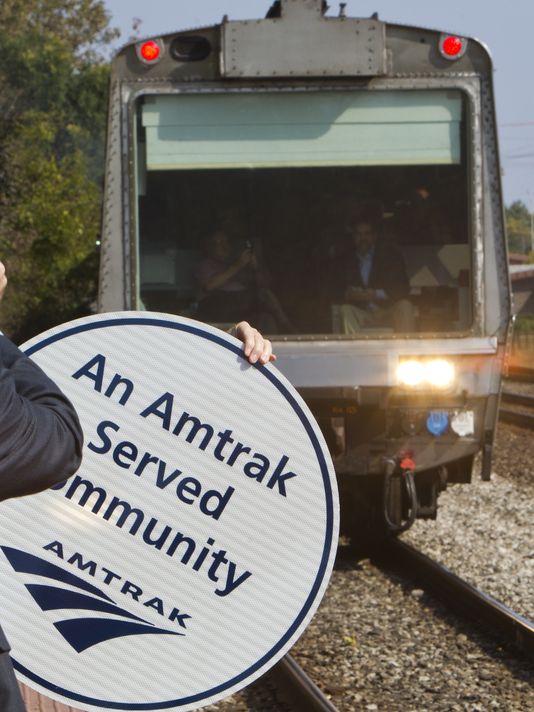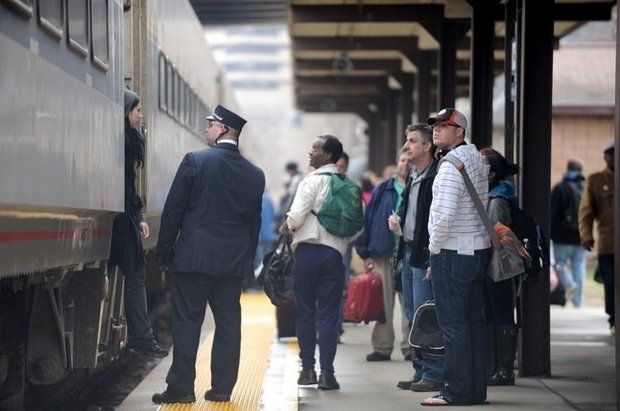The case originated in 2010 when the Association of American Railroads (AAR), on behalf of its freight railroad members, challenged the PRIIA, complaining that the law’s Section 207 improperly delegated to Amtrak, allegedly operated as private, for-profit company, authority to exercise with the FRA joint regulatory control over freight railroads.
In 2012, a federal district court denied the AAR challenge and upheld the law. That decision was overturned in 2013 by an appellate court, which agreed with the AAR that Amtrak is a private company; and that Section 207 of the PRIIA is an unlawful delegation of governmental power to Amtrak.
That the Supreme Court overturned the appellate court does not mean the district court ruling holds. In sending the case back to the U.S. Court of Appeals for the District of Columbia, the Supreme Court ruled only that the appellate court was wrong in concluding Amtrak is a private company. The appellate court now must reconsider the other merits of the AAR’s challenge to the PRIIA’s Section 207.
In fact, concurring opinions by Justices Samuel Alito and Clarence Thomas suggest the AAR may yet prevail because Section 207 of the PRIIA may have overstepped the Constitution’s Delegation of Powers and Appointments clauses by improperly vesting regulatory powers with a private arbitrator and an Amtrak president and board of directors who may lack the necessary constitutional authority notwithstanding Amtrak’s governmental entity designation.
While a final judicial determination could be delayed by at least a year—and longer if the case returns to the Supreme Court—the March 9 decision does not affect other sections of the PRIIA.
Embedded in the Alito and Thomas concurring opinions is an implication that unrelated legislation being drafted in the Senate—to initiate voluntary, but binding, arbitration of freight-shipper rate and service disputes—could be problematic, as will be explained.
As for the March 9 decision affecting Amtrak, when the freight railroads turned their money-losing passenger service over to the newly created and federally owned Amtrak in 1970, it was understood that Amtrak trains primarily would utilize privately owned freight railroad tracks, with Amtrak paying a user charge.
In 1973, Congress gave Amtrak a statutory preference over freight trains. Years of Amtrak train delays—allegedly because freight railroads failed to provide the required preference—caused Congress in 2008 to include the challenged Section 207 in the PRIIA. Section 207 instructed the FRA and Amtrak to develop, in concert with freight railroads, metrics and minimum standards for measuring the performance and service quality of intercity passenger trains.
Section 207 further provided that if the parties could not agree, the Surface Transportation Board could appoint an arbitrator to resolve the dispute through binding arbitration. Failure to meet those arbitrated standards, to be made part of the track-use contracts between Amtrak and freight railroads, would subject freight railroads to monetary damages and a requirement they modify freight operations for the benefit of Amtrak.
The AAR alleged in its initial complaint with the federal district court that Section 207 of the PRIIA unconstitutionally places “legislative and rulemaking authority in the hands of a private entity [Amtrak] that participates in the very industry it is supposed to regulate.”
Without determining if Amtrak is a private company or government entity, the district court ruled in 2012 that even if Amtrak could be deemed a private company, the FRA, STB, Department of Transportation and Congress exercised sufficient control and enforcement over Amtrak so as to turn away any argument that there was an improper delegation of regulatory authority to Amtrak.
In reversing the district court in 2013, the Court of Appeals for the District of Columbia concluded Amtrak is a private company, and thus cannot constitutionally be granted the regulatory power prescribed by Section 207 of the PRIIA. Such power is limited to government entities, said the appellate court.
The Supreme Court said the appellate court’s “premise was flawed” and rejected its finding that Amtrak is a private company. Simply because Congress termed Amtrak “not a department, agency, or instrumentality of the United States Government,” and further made “a pronouncement that Amtrak shall be operated and managed as a for-profit corporation” is not sufficient to classify Amtrak as a private company, ruled the Supreme Court.
It listed reasons why Amtrak is a government entity, including having a board of directors nominated by the President of the United States, confirmed by the Senate, having their salaries set by Congress, and being subject to removal from office, without cause, by the President of the United States. Additionally, said the Supreme Court, Congress exercises “substantial” supervision over Amtrak, including its federal subsidies, budget and route structure, plus Amtrak is subject to congressional oversight hearings. “Amtrak was created by the government, is controlled by the government, and operates for the government’s benefit,” said the Supreme Court.
The justices flubbed the dub, however, in saying “most” of Amtrak’s common stock” is held by the Department of Transportation. In fact, all of Amtrak’s common stock is held primarily by the private-sector American Financial Group and several privately owned freight railroads. This error is probably not fatal, as the other criteria used in determining Amtrak is a public entity are numerous and compelling. (See, “Fini to saga of Amtrak’s common stock.”)
It is now up to the appellate court to revisit the case and determine—with a new understanding that Amtrak is a government entity—whether other allegations of the AAR as to the constitutionality of Section 207 of the PRIIA are valid. And here is where the concurring opinions of Justices Alito and Thomas suggest something is still rotten in Section 207 with regard to appointment of an arbitrator and the structure of the Amtrak board of directors.
“It is hard to imagine how delegating binding, tie-breaking authority to a private arbitrator [appointed by the STB] to resolve a dispute between Amtrak and the FRA could be constitutional,” wrote Alito. Amtrak’s argument ”that the word ‘arbitrator’ does not mean ‘private arbitrator’ is in some tension with the ordinary meaning of the word. We usually think of arbitration as a form of private dispute resolution.”
Moreover, wrote Alito, because the arbitrator would be appointed by the STB rather than nominated by the President of the United States and confirmed by the Senate, the arbitrator is “not accountable to the people … Nothing final should appear in the Federal Register unless a Presidential appointee has at least signed off on it. Then there is the matter of Amtrak’s president and its board of directors.
Citing the Constitution’s Article II Appointments Clause, Justice Thomas doubted whether Amtrak—even as a public entity—is “constitutionally eligible to exercise executive power” such as collaborating with the FRA to establish performance standards. This, wrote Thomas, is, again, because the Amtrak president, appointed by the Amtrak board of directors, does not answer to the people by being nominated by the President of the United States and confirmed by the Senate. The Amtrak president, who could cast a deciding vote if the Amtrak board is deadlocked, should not be inferior to Senate confirmed board members, wrote Thomas.
Justices Alito and Thomas went further, questioning whether the Amtrak board of directors even has constitutional authority to appoint the president of Amtrak. “While I entirely agree with the Court that Amtrak must be regarded as a federal actor for constitutional purposes, it does not by any means necessarily follow that the present structure of Amtrak is consistent with the Constitution,” Alito wrote.
“Congress,” through Section 207 of the PRIIA, wrote Thomas, “has permitted a corporation subject only to limited control by the President [of the United States] to create legally binding rules. This arrangement raises serious constitutional questions to which the majority’s holding that Amtrak is a governmental entity is all but a non sequitur. These concerns merit close consideration by the courts below and by this Court if the case reaches us again. We have too long abrogated our duty to enforce the separation of powers required by our Constitution. We have overseen and sanctioned the growth of an administrative system that concentrates the power to make laws and the power to enforce them in the hands of a vast and unaccountable administrative apparatus that finds no comfortable home in our constitutional structure. The end result may be trains that run on time (although I doubt it), but the cost is to our Constitution and the individual liberty it protects.
Finally, Justices Alito and Thomas, by implication, touched on an issue affecting freight railroads and their freight shippers. When now Senate Commerce Committee Chairman John Thune (R-S.D.) co-sponsored with his predecessor, Jay Rockefeller (D-W.Va.), Senate Bill No. 2777 in the previous Congress, they included a provision to establish a voluntary, but binding, arbitration process to resolve rate, practice and common carrier service-expectation complaints subject to STB jurisdiction. A similar provision is under consideration for inclusion in new legislation this year. Some shippers have been pushing for mandatory, rather than voluntary, arbitration.
In light of this Amtrak decision, and the justices’ concern over a private arbitrator acting independently, as private arbitrators do, it is appropriate to question how a statutorily binding arbitration process for freight railroad-freight shipper disputes might pass constitutional muster. In the end, it would be a private arbitrator, who does “not answer to the people,” making decisions. A mandatory, as opposed to a voluntary, arbitration process seems unlikely now to satisfy the courts.
Whether a voluntary, but binding, arbitration procedure for freight railroads and freight shippers will pass judicial muster depends on its language. The apparent rub with Section 207 of the PRIIA is that Amtrak and the FRA (with or without an arbitrator) have been granted power by Congress to establish rules coercively applied to third party freight railroads.
The implications of this Supreme Court case are many. It would do well for opinion leaders and decision makers to follow events closely.







